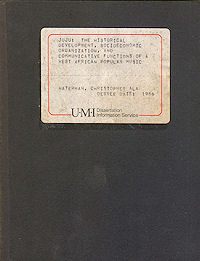waterman1986
|
Waterman, Christopher Allen: |
 CONTENTS
CONTENTS
Chapter 1
The Study of African Urban Popular Musics 1
1.1 Toward a working definition of the term popular music in
sub-Saharan Africa 1
1.2 The ethnomusicological study of African urban popular musics 5
1.3 Africanist urban anthropology and popular music 11
1.4 Style as practice and communication: An approach to the
study of urban popular music in sub-Saharan Africa 23
Chapter 2
Social Heterogeneity, Cultural Pluralism, and Musical Style in Colonial Lagos 40
2.1 The development of Lagos: 15th to late 19th centuries 40
2.2 Social identity and musical expression in early twentieth
century Lagos 49
2.3 Lagosian economy and demography: 1914-1939 65
2.4 Lagosian politics and traditional musical
expression: 1914-1939 68
2.5 Class relations in Lagos during the inter-war period 75
2.6 Islam, Christianity, and music In Lagos: 1918-1939 82
2.7 Identity and musical style in colonial Lagos: an overview 90
Chapter 3
Syncretic Popular Music in Lagos Between the World Wars 94
3.1 Introduction 94
3.2 Sákárà: a neo-traditional Islamicized popular music 94
3.3 Asíkò: a neo-traditional Christian social dance music 107
3.4 Africanized brass band and ballroom dance music 114
3.5 Palmwine guitar music in Lagos: 1920s-1930s 121
3.6 Conclusion 146
Chapter 4
Early Jùjú Style (ca. 1932-1948) 149
4.1 introduction 149
4.2 The early jùjú ensemble 151
4.3 Early jùjú performance style 156
4.4 Early jùjú song texts 161
4.5 Contexts and relations of performance production 169
4.6 The social identity and economic status of early jùjú
practitioners 183
4.7 Preconditions for transformation: Early jùjú style
during the Second World War 193
Notes – Chapter 4 201
Chapter 5
Modern Jùjú Style (ca. 1948-1960s) 203
5.1 Introduction 203
5.2 Post-war changes in jùjú instrumentation and style 204
5.3 The relations of jùjú performance during the post-war period 218
5.4 Mass-reproduction, commercial dissemination, and sub-stylistic
diversification in jùjú music: 1950s-1960s 228
5.5 Two sub-styles of the 196Os: I.K. Dairo and Dele Ojo 253
5.5.1 I.K. Dairo: The dominant jùjú “star” of the post-
Independence period 253
5.5.2 Dele Ojo: Interaction between jùjú and highlife
during the mid-1960s 258
5.6 Jùjú after the Nigerian Civil War (1967-1970) 266
Notes – Chapter 5 270
Chapter 6
Urban Popular Music in the City of Ibadan 272
6.1 Yoruba popular music in Ibadan 272
6.2 The popularity of traditional musics in Ibadan 286
6.3 The socioeconomic organization of Ibadan jùjú ensembles 294
Notes – Chapter 6 318
Chapter 7
Jùjú Performance in Ibadan 319
7.1 Jùjú performance contexts 319
7.1.1 The urban hotel context 319
7.1.2 The neo-traditional ceremonial context 333
7.2 Jùjú performance at Yoruba neo-traditional celebrations 347
7.2.1 Performance roles 349
7.2.2 Performance practice: text and context 356
Notes – Chapter 7 381
Chapter 8
Jùjú Performance an Aesthetic
and Ideological Communication 383
8.1 Performance evaluations 383
8.2 Four aspects of jùjú performance as communication 393
8.3 Conclusion:
The Ideological role of a West African popular music 408
Notes – Chapter 8 421
Publications Cited 422
Curriculum Vitae 446


 CONTENTS
CONTENTS CONTENTS
CONTENTS INHALT (Button Type)
INHALT (Button Type) CONTENTS
CONTENTS